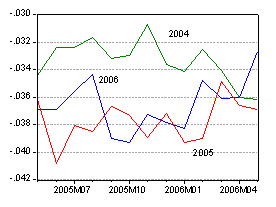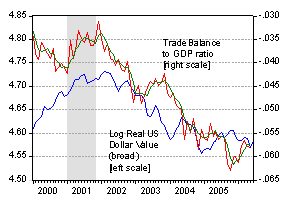I was out of the country when these data were released, so I didn’t immediately write a post on the data. In any case several commentators covered the ground so well I didn’t have much to add immediately. Several forwarded the possibility of trade deficit (as a share of GDP) stabiization (see here and here), in light of the fact that the May trade release which showed a smaller than consensus deficit. In the past I made similar observations (see here). I remain hopeful, but am still not yet convinced.
In the figure below, I plot the trade balance (from the BEA/Census Trade Release of July 12), divided by the interpolated nominal GDP series, in order to obtain a trade balance ratio. The non-oil series looks like it’s stabilizing, at least according
to an a quick glance.

Figure 1: Trade balance and trade balance ex. oil imports, divided by interpolated GDP, assuming 5% nominal GDP growth
in 2006q2, and 3 month moving averages of ratios. Source: BEA/Census May 2006 trade release (June, 2006), and author’s calculations.
Upon further inspection it appears that the non-oil trade balance has only been only slightly higher over the past year relative to the previous year, with the exception of May. In Figure 2, the May to May non-oil trade balance to GDP ratio is plotted for 2006 (blue), 2005 (red) and 2004 (green). The most recent year is slightly more positive than the preceding, but is clearly more negative than 2004.

Figure 2: Trade balance ex. oil imports, divided by interpolated GDP, assuming 5% nominal GDP growth
in 2006q2, May to May for 2006, 2005 and 2004. Source: BEA/Census May 2006 trade release (June, 2006), and author’s calculations.
In addition, while real oil imports seem like they are tailing off, the real (quanta) import series exhibits no decrease from May to May periods. March and April were below levels a year previous, but May’s figure was above the corresponding period last year. Of course, some comfort can be taken from the fact that quantities of petroleum and energy-related petroleum products have not risen despite rapid real GDP growth in recent quarters (see Figure 3).

Figure 3: Petroleum and energy-related petroleum imports, in millions of 2000Ch$,
seasonally adjusted, May to May for 2006, 2005 and 2004. Source: BEA/Census May 2006 trade release (June, 2006).
There is some hope from the recent weakness of the dollar. figure 4 shows that the dollar fell against a broad basket of currencies in real terms in the first part of 2006. The lagged effects might help in the over the longer term, although the depreciation was fairly modest, and the immediate impact of a dollar depreciation is a worsening of the nominal trade balance (given the large excess of imports over exports, and low price elasticities). Hence, no big improvement should be expected when these effects work through.

Figure 4: Trade balance divided by interpolated GDP, assuming 5% nominal GDP growth
in 2006q2, and 3 month moving averages of ratios, and log real value of dollar (Fed broad index). Source: BEA/Census May 2006 trade release (June, 2006), Federal Reserve Board exchange rate statistics, and author’s calculations.
Technorati Tags: trade deficits, oil imports, oil prices, exchange rates
“the immediate impact of a dollar depreciation is a worsening of the nominal trade balance (given the large excess of imports over exports, and low price elasticities)”
Could you explain ? I have trouble understanding that…
Thanks a lot
Cheaper Dollar means that our exports sell for less, while it costs us more to buy imports.
RAK: Greg is right. The general idea is a dollar depreciation means that the prices (in dollar terms) rise in response to the depreciation. Quantities respond as well, but not much to begin with. If trade is imbalanced, such that imports exceed exports, then the dollar value of imports rises by more than the value of exports, then the trade balance expressed in dollar terms may deteriorate, or not increase, in the immediate wake of the depreciation. See these notes [pdf] for a mathematical treatment.